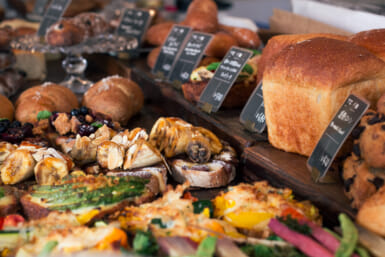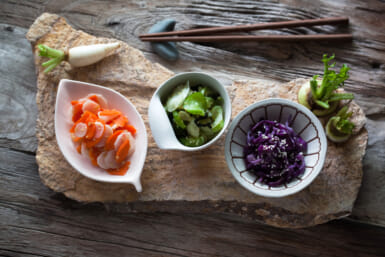with Donna Sweeny
Cooking with Fresh Herbs
Many of us have delighted the variety and choice of herbs which are so readily available — yet another indication of the increasing interest in creative cooking. There is no questioning the convenience of dried herbs, but a real reward awaits those who opt for using fresh herbs.
Learning to cook with fresh herbs is well worth the effort; the heightened flavor and aroma they impart will more than compensate for the small amount of extra lime and work involved. The ideal situation, of course, would be to have an herb garden; for most city dwellers this is impractical if not impossible. But if you have a sunny window sill, there are many herbs which will grow well in small pots, providing you with an ever-ready supply; chives, dill and parsley are good choices.
If you have a bit more space, you might try raising basil — I did this on my terrace in New York for years and dinner guests were always amused when I went outside to pick basil for the pesto sauce.
Fortunately, even “flower pot” gardening is not necessary; many of the large food markets in Tokyo now sell fresh herbs, and with curiosity and a willingness lo experiment, even the beginner will soon become initiated to the aromatic subtleties of herbal seasonings.
When buying fresh herbs, look for a bright green color; wash them carefully under cold running water and hang them to dry. For larger-leafed herbs, a salad spinner can be used for drying. Since fresh herbs contain a lot of water, their flavor is not as strong as dried; one tablespoon of chopped fresh herbs is equal in strength to 1/4 to 1/3 teaspoon of dried. If at all in doubt, use a light hand — a little goes a long way. Prolonged cooking strengthens the pungency of herbs, so if you want the merest hint of flavor add the herbs during the last few minutes of cooking.
Besides drying, an easy way of preserving herbs is freezing: this works particularly well with flat-leafed herbs such as mini and basil. Just wash and thoroughly dry the leaves, put them in plastic bags and store them flat in the freezer where they will keep for two or three months. Whole or chopped, they are a welcome addition to soups, stews and casseroles.
Another way to flavor sauces and stews is to use a bouquet garni. The classic mixture is fresh thyme, parsley and a bay leaf, but other herbs may be used. Tie the herbs together in a square of cheesecloth and tie the bouquet to the handle of the pot for easy retrieval.
I recently had the pleasure of learning more about cooking with fresh herbs in a class conducted by Chef Mario Martinez, owner of 24 Carrot Cuisine, one of South Florida’s most popular catering services.
Chef Martinez, who is known for his innovative and creative use of fresh herbs, pointed out that while dried herbs are convenient, fresh herbs impart a different flavor and aroma. He stressed, too, the importance of experimentation to find the herbs and herb mixtures which are best suited to your taste. In his recipe for roast new potatoes which follows, for example, chives, tarragon or basil could be substituted for the dill; oregano would work as well as rosemary with the braised chicken.
Chef Martinez’s recipes reflect his creative approach to herbal cooking as well as the hearty cuisine of his native Spain. He is delighted to share his recipes with Weekender readers.
Chilled Avocado Soup with Cilantro Salsa (serves 4)
Cilantro Salsa:
- 2 small tomatoes
- 1 2-inch piece cucumber
- 1/2 red bell pepper
- 1 jalapeno pepper
- 2 scallions
- 1 small clove garlic
- 1 tablespoon minced fresh cilantro leaves
- Pinch cumin
- Salt to taste
Soup:
- 2 ripe avocados
- 4 teaspoons lime juice
- 4 teaspoons lemon juice
- 2 cups chicken stock
- 1 1/3 cups light cream
- Salt and freshly ground pepper to taste
For the salsa, peel, seed and chop the tomatoes and cucumber. Seed and chop bell pepper. Carefully remove seeds and ribs and then mince the jalapeno. Mince the scallions and garlic. Combine all salsa ingredients and let stand 15 minutes at room temperature.
For the soup, peel and pit the avocados, Puree the avocados in a food processor with lemon and lime juice. Add the stock, cream, salt and pepper. Blend well and chill. To serve, put soup into individual bowls and lop with a dollop of salsa.
Cucumber Salad Damascus
- 2 cucumbers
- 1/2 cup yogurt
- 2 tablespoons olive oil
- 1 clove garlic, peeled, mashed, and minced
- 1 teaspoon lemon juice
- 2 tablespoons chopped fresh chives
- 2 tablespoons chopped fresh mint leaves
- Salt and freshly ground pepper to taste
Peel cucumbers and cut in thin slices. Mix all ingredients together, except chives and mint, until well blended. Add cucumber slices and mix well. Salad can be made several hours before serving to allow cucumber slices to absorb flavor. Garnish with mint and chives just before serving.
Roast New Potatoes with Baked Garlic and Dill (serves 4)
- 3-4 pounds new potatoes, well scrubbed
- 1/4 pound butter
- 1/2 cup olive oil
- 8 cloves garlic
- Salt and freshly ground pepper to taste
- 1 bunch fresh dill, chopped
Cut the potatoes into halves or Ihirds depending on their size. Melt the butter and pour it into a roasting pan with the olive oil. Place the garlic on a cutting board, cut off the root end and gently press on each clove with side of a chefs knife; this will crack and loosen the skin but leave it intact. Place the potatoes and garlic in the pan and bake at 350° for 20 – 30 minutes, basting occasionally with the butter and oil mixture, until the potatoes are tender to the touch.
Remove the garlic from the pan and peel each clove. In a small bowl, mash the baked garlic, add some of the oil from the pan and mix in the dill. Pour over the potatoes, salt and pepper to taste, and mix thoroughly. Run under the broiler until the potatoes are crunchy.
Greek Braised Chicken Legs with Rosemary (serves 8)
- 16 chicken legs
- 4 cloves garlic, mashed and chopped
- 1 bunch fresh rosemary leaves (no stems)
- 1/4 cup olive oil
- 2 tablespoons butter
- Juice of 1 lemon
- 1 cup dry vermouth (dry sherry may be substituted)
- 1/2 cup fresh parsley, chopped
- Salt and pepper to taste
Holding each chicken leg by the bone, make two diagonal cuts, right to the bone, in the fleshy part of the leg. Mix the garlic and rosemary together and put the mixture into the cuts. In a large frying pan, over high heat, fry the chicken legs, turning occasionally to brown on all sides. Reduce the heat to a simmer and add all other ingredients except parsley. Cook for about 15 minutes, turning legs occasionally, until done. Add parsley and serve with pasta or rice.








